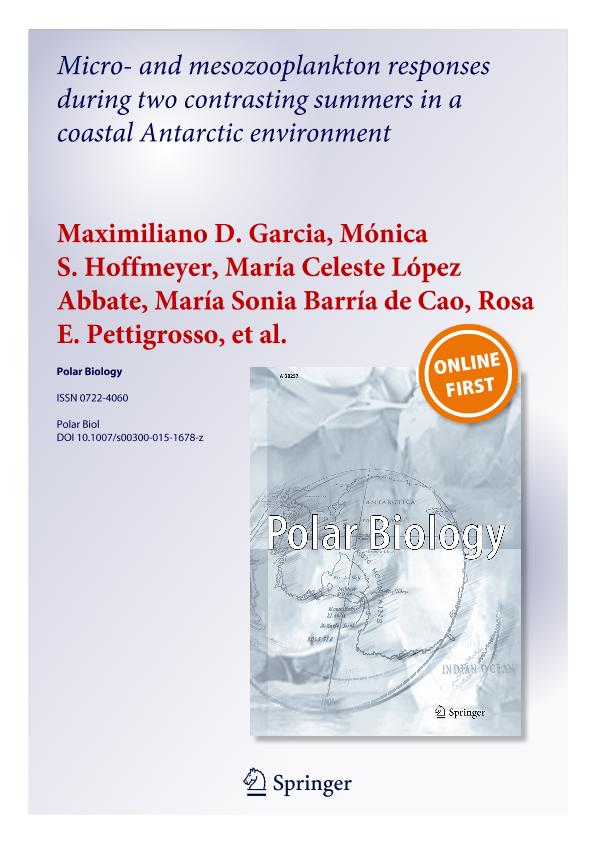Mostrar el registro sencillo del ítem
dc.contributor.author
Garcia, Maximiliano Darío

dc.contributor.author
Hoffmeyer, Monica Susana

dc.contributor.author
López Abbate, María Celeste

dc.contributor.author
Barría de Cao, María Sonia
dc.contributor.author
Pettigrosso, Rosa E.
dc.contributor.author
Almandoz, Gaston Osvaldo

dc.contributor.author
Hernando, Marcelo P.
dc.contributor.author
Schloss, Irene Ruth

dc.date.available
2017-02-06T20:50:48Z
dc.date.issued
2015-01
dc.identifier.citation
Garcia, Maximiliano Darío; Hoffmeyer, Monica Susana; López Abbate, María Celeste; Barría de Cao, María Sonia; Pettigrosso, Rosa E.; et al.; Micro- and mesozooplankton responses during two contrasting summers in a coastal Antarctic environment; Springer; Polar Biology; 39; 1; 1-2015; 123-137
dc.identifier.issn
0722-4060
dc.identifier.uri
http://hdl.handle.net/11336/12560
dc.description.abstract
Rapid climate-driven melting of coastal glaciersmay control plankton dynamics in the WesternAntarctic Peninsula. It is known that in Potter Cove, 25 deMayo/King George Island, phytoplankton is tightly coupledto meltwater input. However, no information onzooplankton is available in this regard. The aim of thisstudy was therefore to examine the structure and dynamicsof microzooplankton and mesozooplankton in two zones(the inner and outer Potter Cove) differently impacted byglacier melting during two contrasting austral summers(2010 and 2011). Microzooplankton composition differedbetween the two zones and years analyzed, and its totalbiomass was observed to be highest far from the glacierinfluence and during 2010. Mesozooplankton compositionand biomass were similar in the two zones and yearsanalyzed. Colder than usual conditions in the summer of2010 prevented glacier melting, thus favoring the developmentof an exceptional micro-sized diatom bloom(*190 lgCl-1 and [15 lg l-1 chlorophyll a), whichwas tightly followed by a maximum in large copepodabundance. After the bloom and in coincidence with intenseglacier melting, large diatoms and large copepodswere observed to be replaced by nanophytoplankton andmicrozooplankton (aloricate ciliates and dinoflagellates),respectively. In 2011, low phytoplankton abundance,probably controlled by high tintinnid biomass, was observedas a result of warmer temperatures than 2010 andlow-salinity waters. Large copepods appeared to have exerteda high grazing pressure on aloricate ciliates andheterotrophic dinoflagellates in 2011. Our results suggestthat whereas the joint effect of water temperature, salinityand phytoplankton availability as well as compositioncould be of primary relevance in structuring micro- andmesozooplankton community, zooplankton could be ofsecondary relevance in controlling phytoplankton biomassin Potter Cove during the two summers analyzed.
dc.format
application/pdf
dc.language.iso
eng
dc.publisher
Springer

dc.rights
info:eu-repo/semantics/openAccess
dc.rights.uri
https://creativecommons.org/licenses/by-nc-sa/2.5/ar/
dc.subject
Western Antarctic Peninsula
dc.subject
Microzooplankton
dc.subject
Mesozooplankton
dc.subject
Biomass
dc.subject
Top-Down/Bottom-Up
dc.subject.classification
Oceanografía, Hidrología, Recursos Hídricos

dc.subject.classification
Ciencias de la Tierra y relacionadas con el Medio Ambiente

dc.subject.classification
CIENCIAS NATURALES Y EXACTAS

dc.title
Micro- and mesozooplankton responses during two contrasting summers in a coastal Antarctic environment
dc.type
info:eu-repo/semantics/article
dc.type
info:ar-repo/semantics/artículo
dc.type
info:eu-repo/semantics/publishedVersion
dc.date.updated
2017-02-03T17:53:33Z
dc.identifier.eissn
1432-2056
dc.journal.volume
39
dc.journal.number
1
dc.journal.pagination
123-137
dc.journal.pais
Alemania

dc.journal.ciudad
Berlin
dc.description.fil
Fil: Garcia, Maximiliano Darío. Consejo Nacional de Investigaciones Científicas y Técnicas. Centro Científico Tecnológico Bahía Blanca. Instituto Argentino de Oceanografía (i); Argentina
dc.description.fil
Fil: Hoffmeyer, Monica Susana. Consejo Nacional de Investigaciones Científicas y Técnicas. Centro Científico Tecnológico Bahía Blanca. Instituto Argentino de Oceanografía (i); Argentina. Universidad Tecnológica Nacional. Facultad Regional Bahía Blanca; Argentina
dc.description.fil
Fil: López Abbate, María Celeste. Consejo Nacional de Investigaciones Científicas y Técnicas. Centro Científico Tecnológico Bahía Blanca. Instituto Argentino de Oceanografía (i); Argentina
dc.description.fil
Fil: Barría de Cao, María Sonia. Consejo Nacional de Investigaciones Científicas y Técnicas. Centro Científico Tecnológico Bahía Blanca. Instituto Argentino de Oceanografía (i); Argentina
dc.description.fil
Fil: Pettigrosso, Rosa E.. Universidad Nacional del Sur. Departamento de Biología, Bioquímica y Farmacia; Argentina
dc.description.fil
Fil: Almandoz, Gaston Osvaldo. Universidad Nacional de la Plata. Facultad de Ciencias Naturales y Museo. Division Ficologia; Argentina. Consejo Nacional de Investigaciones Científicas y Técnicas; Argentina
dc.description.fil
Fil: Hernando, Marcelo P.. Comision Nacional de Energia Atomica; Argentina
dc.description.fil
Fil: Schloss, Irene Ruth. Ministerio de Relaciones Exteriores, Comercio Interno y Culto. Dirección Nacional del Antártico. Instituto Antártico Argentino; Argentina. Université du Québec à Rimouski; Canadá. Consejo Nacional de Investigaciones Científicas y Técnicas; Argentina
dc.journal.title
Polar Biology

dc.relation.alternativeid
info:eu-repo/semantics/altIdentifier/url/http://link.springer.com/article/10.1007%2Fs00300-015-1678-z
dc.relation.alternativeid
info:eu-repo/semantics/altIdentifier/doi/http://dx.doi.org/10.1007/s00300-015-1678-z
Archivos asociados
